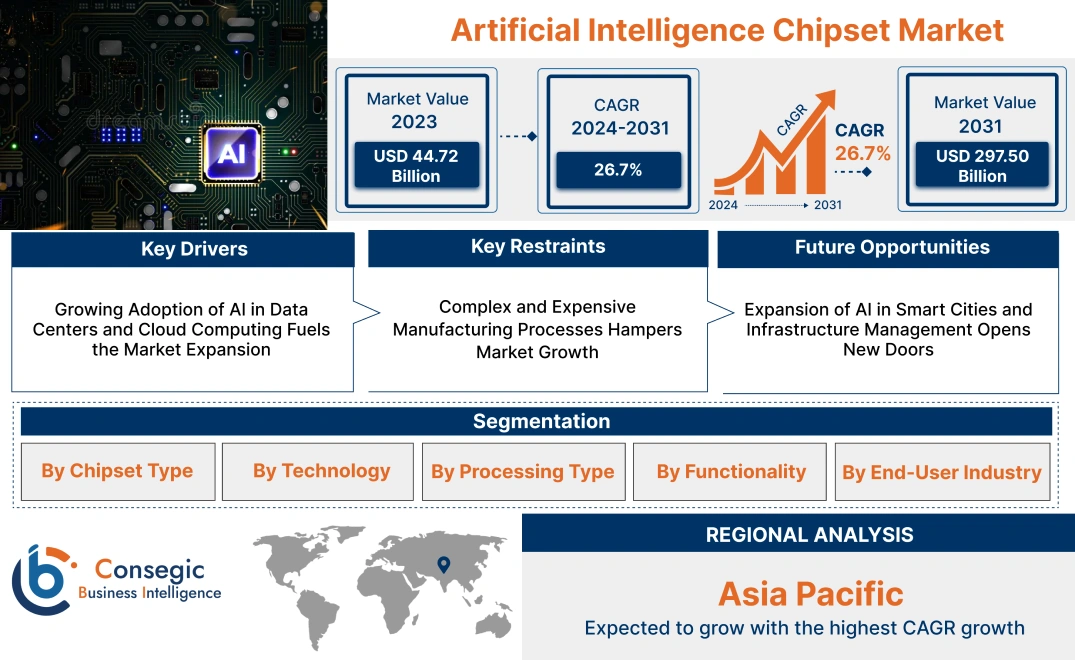Artificial Intelligence Chipset Market Size:
Artificial Intelligence Chipset Market is estimated to reach over USD 488.22 Billion by 2032 from a value of USD 57.12 Billion in 2024 and is projected to grow by USD 74.03 Billion in 2025, growing at a CAGR of 26.6% from 2025 to 2032.
Artificial Intelligence Chipset Market Scope & Overview:
Artificial intelligence chipset also known as AI accelerator or AI processor, is a dedicated hardware component designed mainly to efficiently handle the unique and computationally rigorous workloads of AI applications. When compared to general-purpose CPUs, these chipsets are optimized for parallel processing and the massive calculations which are required for tasks such as machine learning, deep learning, and computer vision. Further, the chipsets are used for a wide range of applications including consumer electronics, automotive, manufacturing, BFSI, healthcare, and others. Further, main benefits of the chipsets include greater energy efficiency, improved performance, enhanced speed, as well as lower latency. Furthermore, key trends driving the market include significant growth in demand for generative AI and large language models, rising adoption of edge computing across industries, and growing focus on developing energy-efficient and highly specialized hardware.
How is AI Impacting the Artificial Intelligence Chipset Market?
AI is the primary catalyst and key driver of the AI chipset market. The growing complexity of AI models, mainly large language models and generative AI, are generating a huge demand for specialized hardware that are capable of handling massive parallel computations. This has driven a significant shift away from general-purpose CPUs to highly optimized chipsets like ASICs, GPUs, and FPGAs. Further, AI's evolution is directly driving a market trend toward greater hardware specialization, enhanced energy efficiency, and innovation in chip architectures to meet the needs of cloud-based training as well as real-time edge inference.
Artificial Intelligence Chipset Market Dynamics - (DRO) :
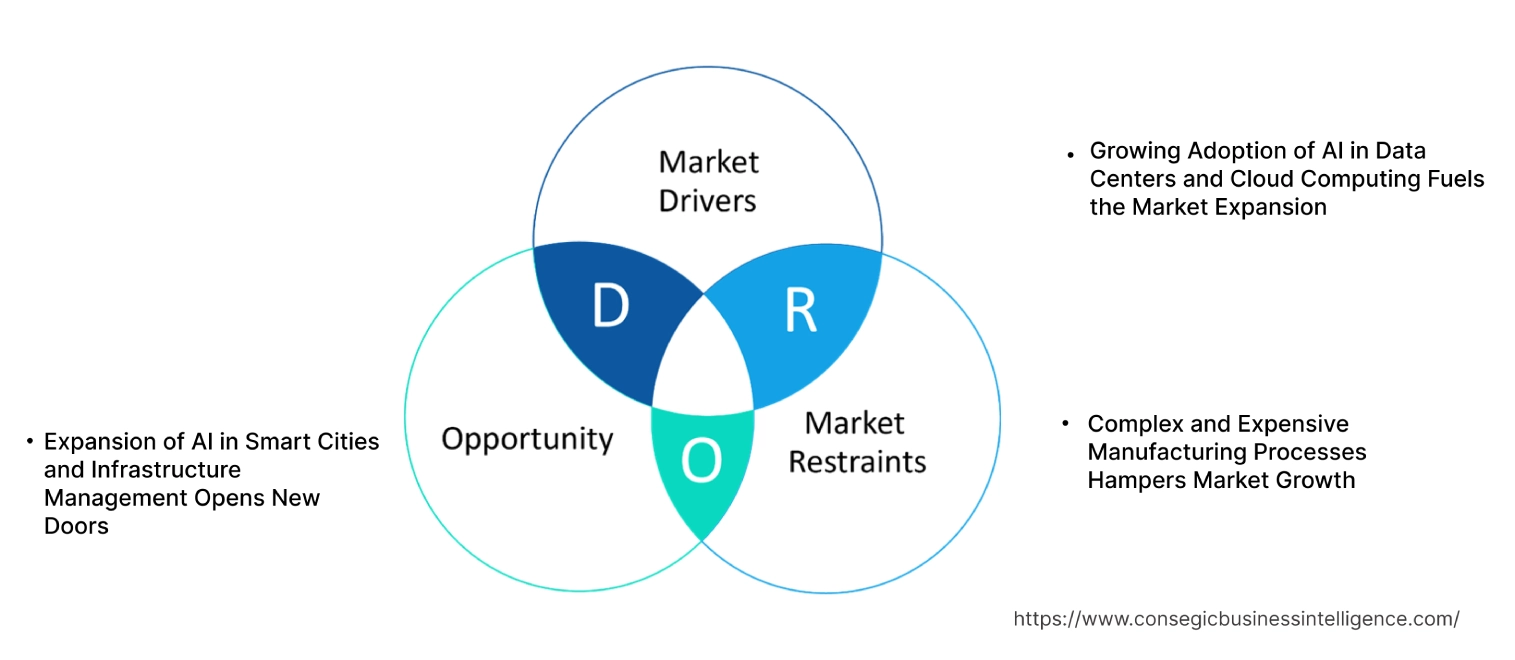
Key Drivers:
Growing Automotive Industry Drives the Market Growth
The rising automotive sector is a major driver of the AI chipset market due to growing integration of intelligent features into vehicles. The drive towards Advanced Driver-Assistance Systems (ADAS) and fully autonomous driving necessitates powerful, dedicated AI processors that can handle real-time data from various sensors, including LiDAR, cameras, and radar. Moreover, AI based chipsets are important for improving in-vehicle infotainment systems, enhancing battery management in electric vehicles (EVs), and enabling predictive maintenance. The transformation from traditional vehicles to "software-based vehicles" generates an enormous need for high-performance and energy-efficient AI hardware.
- For instance, globally production of automobiles according to European Automobile Manufacturers' Association (ACEA), reached 85.4 million units in 2022, witnessing a rise of 5.7% from 2021.
Thus, continuous evolution toward autonomous and software-defined vehicles drives the automotive sector which significantly propels the artificial intelligence chipset market size.
Key Restraints :
High Development and Fabrication Costs are Limiting the Market
The substantial cost associated with developing and fabricating specialized AI chipsets is a major restraint on market growth. As technology nodes shrink to 5nm and below to boost performance, the research and design expenses, along with the capital expenditures for advanced manufacturing equipment, escalate dramatically. This creates a high barrier to entry, limiting the number of companies that can compete in the market and concentrating power in the hands of a few well-funded industry giants. Furthermore, high costs are passed on to end-users, potentially limiting the widespread adoption of AI hardware, particularly for small and medium-sized enterprises (SMEs).
Future Opportunities :
Rise of Generative AI Drives Artificial Intelligence Chipset Market Opportunities
The rise of generative AI is a major catalyst for market prospects in the artificial intelligence chipset. The development and deployment of generative AI models, such as large language models, require immense computational power for both the initial training and subsequent inference phases. This has created an unprecedented demand for high-performance, specialized AI hardware, with a particular emphasis on GPUs and ASICs. The opportunity lies in providing next-generation chips that offer superior efficiency and speed to handle the complex, parallel calculations of these models. Furthermore, as generative AI moves from the cloud to the edge, there is a new frontier for specialized, low-power chipsets to enable real-time content generation on consumer devices, expanding the market far beyond traditional data centers.
Thus, continued proliferation of generative AI will drive the artificial intelligence chipset market opportunities.
Artificial Intelligence Chipset Market Segmental Analysis :
By Chipset Type:
Based on the chipset type, the market is segmented into Graphics Processing Units (GPUs), Application-Specific Integrated Circuits (ASICs), Field-Programmable Gate Arrays (FPGAs), Central Processing Units (CPUs), and others.
Trends in the Chipset Type:
- Increasing emphasis on growth of more power-efficient GPU architectures and sophisticated cooling solutions in turn drives the artificial intelligence chipset market trends.
- Increasing use of FPGAs in applications where consistency and ultra-low latency is important which is expected to drive Artificial Intelligence Chipset market size.
Graphics Processing Units (GPUs) accounted for the largest revenue share of 38.34% in the year 2024.
- Increasing trend of integrating high-bandwidth memory directly into the GPU package, drastically results in increased memory bandwidth and reduces data bottlenecks which in turn drives the artificial intelligence chipset market share.
- Further, there is an increasing focus on using multi-chipset designs and 3D stacking, driving the market.
- Furthermore, GPU includes specialized cores and architecture which are precisely designed for AI tasks in turn driving the artificial intelligence chipset market trends.
- For instance, in October 2024, AMD released new Ryzen AI Pro 300 series processors for business laptops. The chips have a built-in AI engine that makes laptops smarter and more efficient. Further, these laptops can handle today's AI work better, all while saving battery life.
- Thus, as per analysis,high-bandwidth memory integration, increased specialization, and advanced packaging are driving the market.
Application-Specific Integrated Circuits (ASICs) is anticipated to register the fastest CAGR during the forecast period.
- Increasing emphasis on designing ASICs for a specific AI task to achieve maximum performance and power efficiency is driving the market.
- Further, growing adoption of ASICs for edge AI applications which is enabling AI processing on devices like smartphones and wearables in turn propelling the artificial intelligence chipset market expansion.
- Therefore, based on analysis, hyper-specialization and edge AI dominance are anticipated to boost the market during the forecast period.
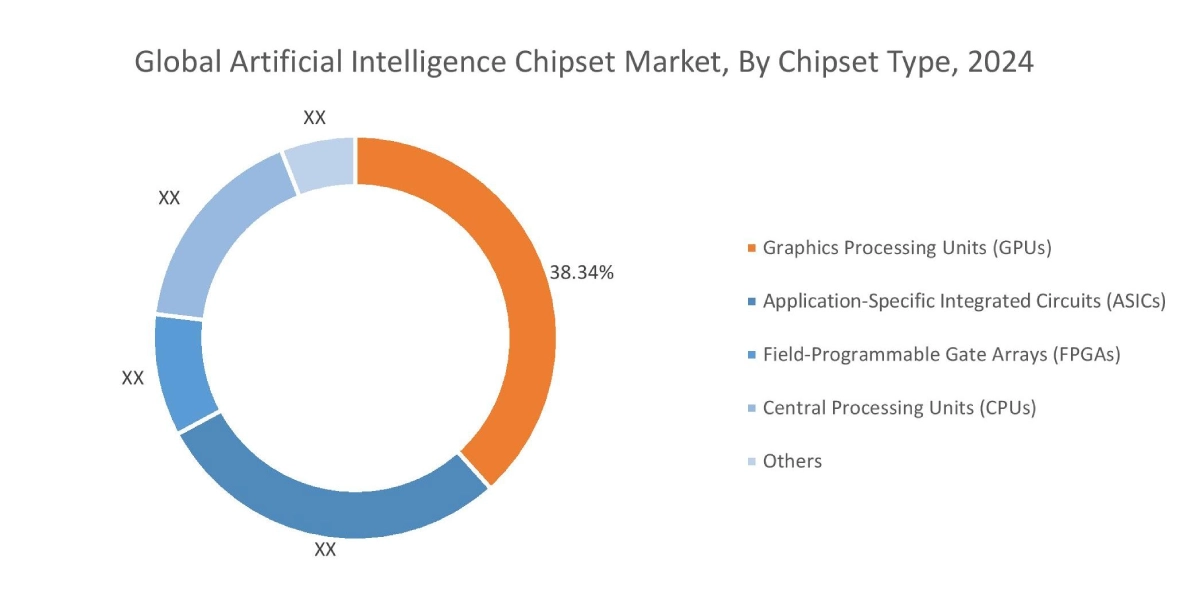
By Processing Type:
Based on the processing type, the market is segmented into edge AI processing and cloud AI processing.
Trends in the Processing Type:
- Processing sensitive data locally on a device to focus on security and privacy drives the artificial intelligence chipset market demand.
- Cloud AI is increasingly being used to automate a large number of tasks including data management, security monitoring, and resource optimization in turn driving the artificial intelligence chipset market share.
Cloud AI processing accounted for the largest revenue share in the year 2024 and is anticipated to register the fastest CAGR during the forecast period.
- Cloud providers are increasingly offering sophisticated AI services that allow businesses to leverage advanced AI capabilities in turn driving the market.
- Further, organizations are moving towards multi-cloud and hybrid cloud strategies which in turn drive the artificial intelligence chipset industry.
- Additionally, cloud platforms are making AI more accessible through no-code/low-code solutions and user-friendly interfaces in turn driving the market.
- Thus, as per artificial intelligence chipset market analysis, democratization of AI, AI-as-a-service, and multi-cloud and hybrid deployments are driving the market.
By Functionality:
Based on the functionality, the market is segmented into training and inference.
Trends in the Functionality:
- There's a significant growth of large language models (LLMs) and generative AI models which in turn drives the artificial intelligence chipset market expansion.
- Growing development of high-speed interconnects and advanced packaging technologies propels the artificial intelligence chipset market demand.
Inference accounted for the largest revenue share in the year 2024 and is anticipated to register the fastest CAGR during the forecast period.
- The growing focus to perform inference on-device for applications including to autonomous vehicles, smart homedevices, and mobile phones, driving the market.
- Further, rise of generative AI inference for applications such as chatbots and content creation is driving the artificial intelligence chipset market growth.
- Furthermore, hybrid cloud-edge architecture and focus on hardware specialization which in turn drives artificial intelligence chipset market growth.
- Thus, based on analysis, aforementioned trends are driving the market.
By End-User:
Based on the end user, the market is segmented into automotive, consumer electronics, data centers, healthcare, industrial, IT & telecom, BFSI, and others.
Trends in the End User:
- Data centers require massive clusters of high-performance AI chipsets to handle the training and inference which in turn drives the artificial intelligence chipset market.
- Growing use of chipset for network optimization and management is driving the market.
Consumer electronics accounted for the largest revenue share in the year 2024.
- Increasing use of Neural Processing Units (NPUs) or other AI accelerators in smartphones, smart speakers, and wearables drives the market.
- Further, emphasis on personalized user experiences drives the need for AI chipsets.
- Furthermore, AI chipsets are increasingly being miniaturized and designed for extreme power efficiency, which in turn drives the market.
- Thus, as per artificial intelligence chipset market analysis, miniaturization & power efficiency and personalization are driving the market.
Healthcare is anticipated to register the fastest CAGR during the forecast period.
- There is an increasing use of chipsets to accelerate medical imaging analysis, which in turn helps to detect diseases like cancer or neurodegenerative disorders.
- Further, there is growing adoption of chipsets in next-generation surgical robots, enabling them to perform complex and minimally invasive procedures in turn propelling the artificial intelligence chipset market development.
- Therefore, based on analysis, robotics and automated surgery and AI for diagnostics and imaging are anticipated to boost the market during the forecast period.
Regional Analysis:
The regions covered are North America, Europe, Asia Pacific, Middle East and Africa, and Latin America.
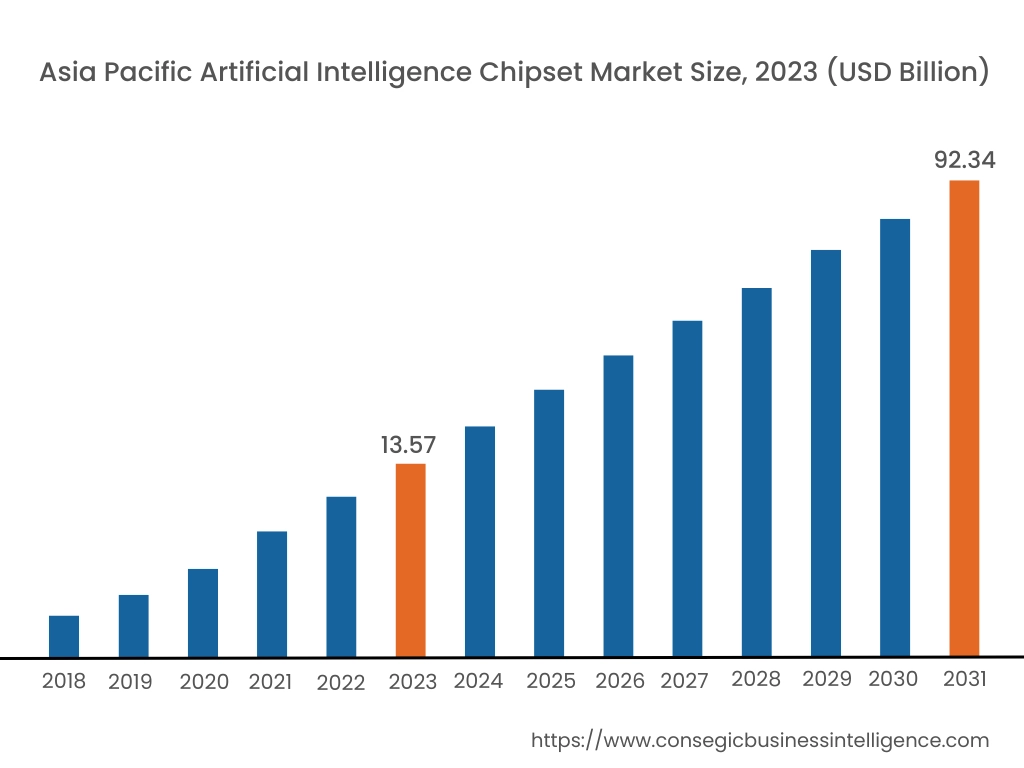
Asia Pacific region was valued at USD 17.61 Billion in 2024. Moreover, it is projected to grow by USD 22.88 Billion in 2025 and reach over USD 154.86 Billion by 2032. Out of this, China accounted for the maximum revenue share of 32.50%. The market for artificial intelligence chipset is mainly driven by rapid digital transformation across various industries and increasing government initiatives. Additionally, growing use of AI-powered applications in key sectors such as consumer electronics, automotive, and healthcare is further driving the market.
- For instance, according to IEA, electric car sales globally surpassed 17 million units in 2024. Also, China’s electric car sales accounts for nearly half of all new car sales in 2024, making it a dominant force in the global EV market.
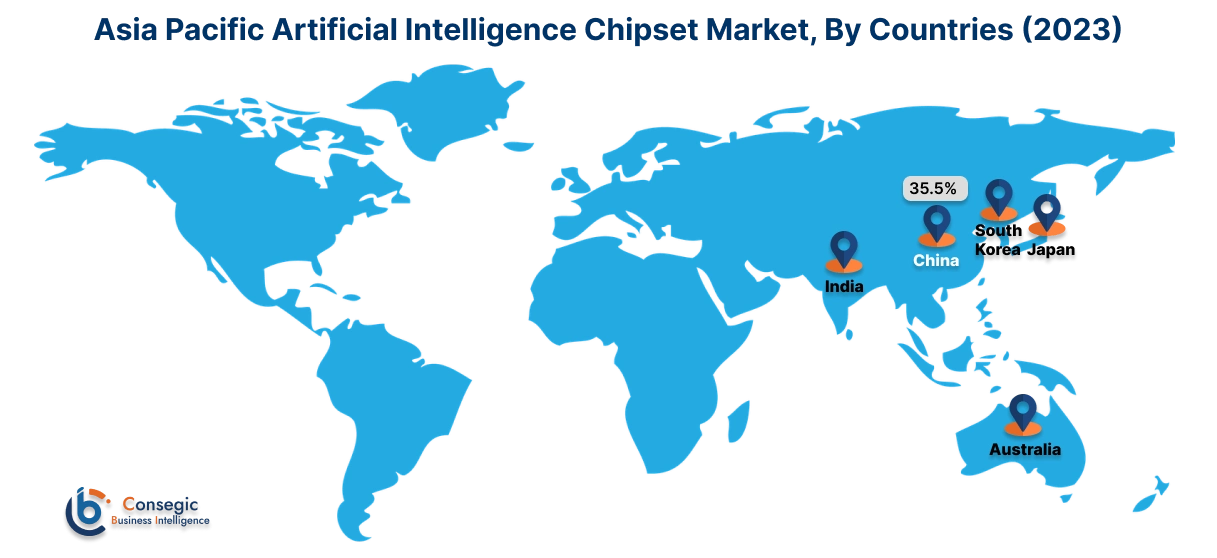
North America is estimated to reach over USD 175.81 Billion by 2032 from a value of USD 20.42 Billion in 2024 and is projected to grow by USD 26.49 Billion in 2025. The North American market is primarily driven by robust ecosystem of major technology companies and significant private and public investment in AI research and development.
- For instance, in August 2024, AMD finalized the acquisition of Silo AI, Europe's largest private AI lab. This strategic move is expected to strengthen AMD's commitment to deliver comprehensive AI solutions. Further, the acquisition is projected to accelerate the development of advanced AI models and platforms.
The regional analysis depicts that growing focus on industry 4.0 and focus on ethical AI development in Europe is driving the market. Additionally, significant investments in developing AI-powered data centers and smart city infrastructure are driving the market in the Middle East and African region. Further, push for digital transformation and adoption of AI-powered solutions to enhance customer service is paving the way for the progress of market progress in Latin America region.
Top Key Players & Market Share Insights:
The global Artificial Intelligence Chipset market is highly competitive with major players providing solutions to the national and international markets. Key players are adopting several strategies in research and development (R&D), product innovation, and end-user launches to hold a strong position in the Artificial Intelligence Chipset industry. Key players in the global Artificial Intelligence Chipset market include-
- NVIDIA Corporation(US)
- Amazon (US)
- Samsung Electronics (South Korea)
- MediaTek (Taiwan)
- SambaNova Systems (US)
- Advanced Micro Devices, Inc.(US)
- Intel (US)
- Qualcomm (US)
- Google (US)
- Huawei (China)
Recent Industry Developments :
- In September 2025, Nvidia launched next-generation Rubin CPX AI chips, which are specifically designed to handle massive-context processing for sophisticated tasks like creating videos and software. This integrated solution is designed to provide customers with groundbreaking speed and efficiency for next-generation AI workloads.
Artificial Intelligence Chipset Market Report Insights :
| Report Attributes | Report Details |
| Study Timeline | 2018-2031 |
| Market Size in 2031 | USD 488.22 Billion |
| CAGR (2024-2031) | 26.6% |
| By Chipset Type |
|
| By Processing Type |
|
| By Functionality |
|
| By End User |
|
| By Region |
|
| Key Players |
|
| North America | U.S. Canada Mexico |
| Europe | U.K. Germany France Spain Italy Russia Benelux Rest of Europe |
| APAC | China South Korea Japan India Australia ASEAN Rest of Asia-Pacific |
| Middle East and Africa | GCC Turkey South Africa Rest of MEA |
| LATAM | Brazil Argentina Chile Rest of LATAM |
| Report Coverage |
|
Key Questions Answered in the Report
How big is the Artificial Intelligence Chipset market? +
The Artificial Intelligence Chipset market is estimated to reach over USD 488.22 Billion by 2032 from a value of USD 57.12 Billion in 2024 and is projected to grow by USD 74.03 Billion in 2025, growing at a CAGR of 26.6% from 2025 to 2032.
What specific segmentation details are covered in the Artificial Intelligence Chipset report? +
The artificial intelligence chipset report includes specific segmentation details for chipset type, processing type, functionality, end user, and regions.
Which is the fastest segment anticipated to impact the market growth? +
In the artificial intelligence chipset market, edge AI processing is the fastest growing segment during the forecast period.
What are the key trends in the artificial intelligence chipset market? +
The artificial intelligence chipset market is being shaped by several key trends including significant growth in demand for generative AI and large language models, rising adoption of edge computing across industries, and growing focus on developing energy-efficient and highly specialized hardware.
Who are the major players in the artificial intelligence chipset market? +
The key participants in the artificial intelligence chipset market are NVIDIA Corporation (US), Advanced Micro Devices, Inc. (US), Intel (US), Qualcomm (US), Google (US), Huawei (China), Amazon (US), Samsung Electronics (South Korea), MediaTek (Taiwan), SambaNova Systems (US), and others.
